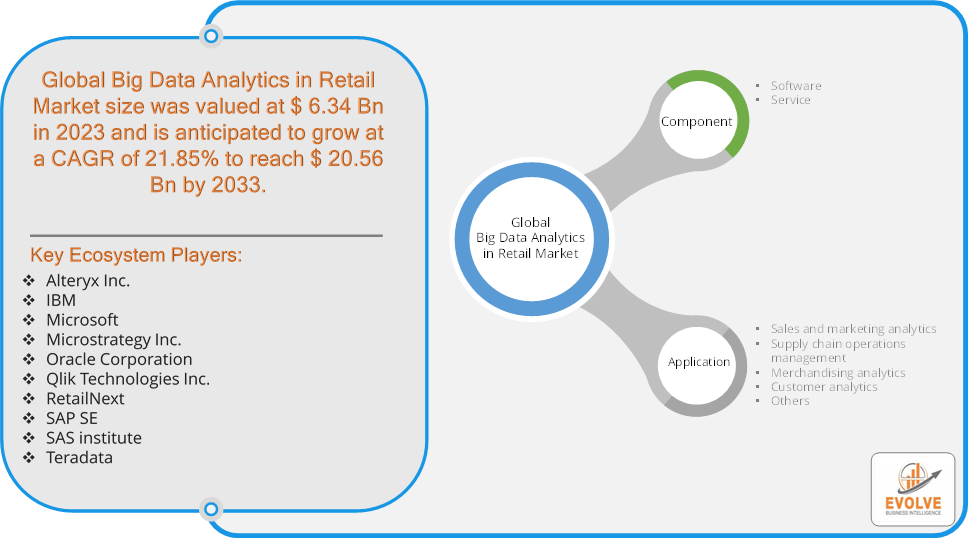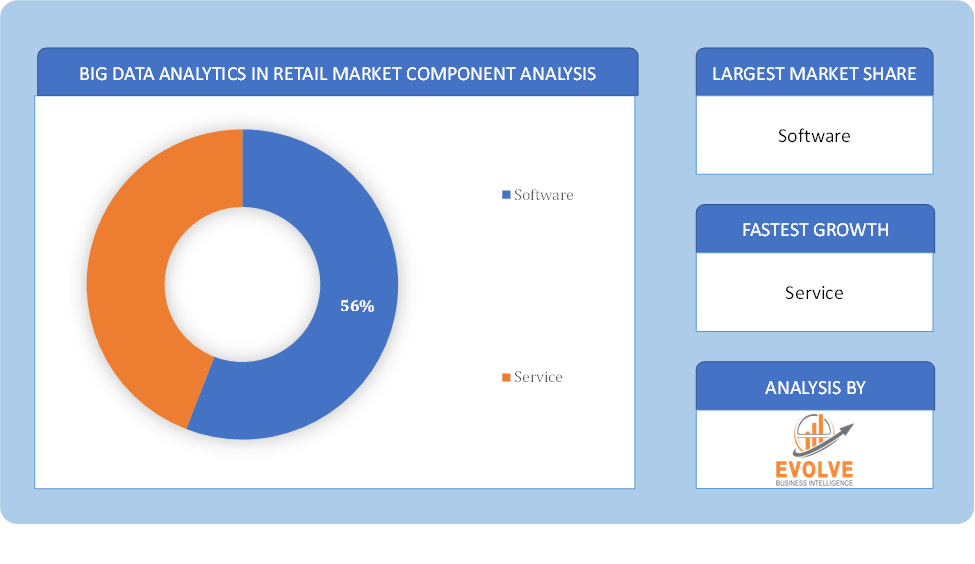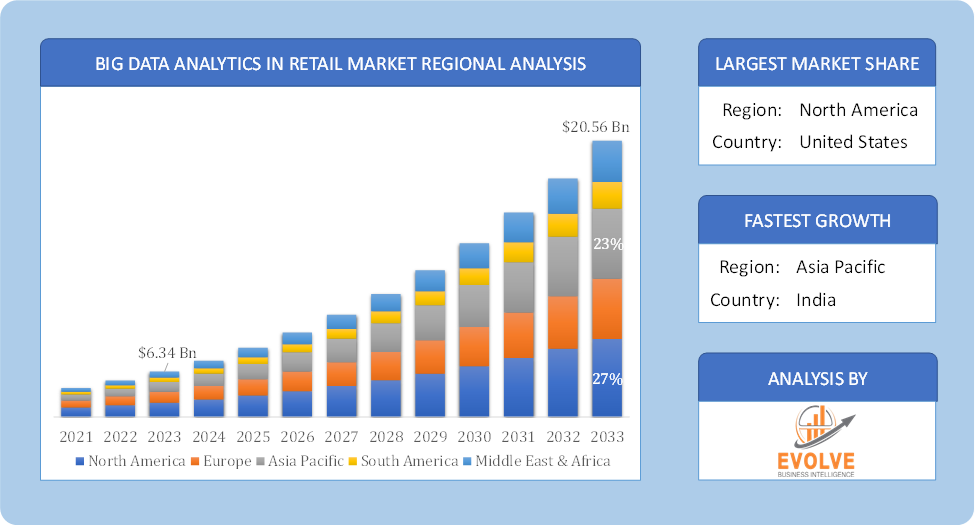Big Data Analytics in Retail Market Overview
The Big Data Analytics in Retail Market Size is expected to reach USD 20.56 Billion by 2033. The Big Data Analytics in Retail Market industry size accounted for USD 6.34 Billion in 2023 and is expected to expand at a compound annual growth rate (CAGR) of 21.85% from 2023 to 2033. The Big Data Analytics in Retail Market refers to the use of advanced data analytics tools and techniques to analyze vast amounts of data generated in the retail sector. This data can come from various sources, including customer transactions, social media, inventory management, customer feedback, and more. The primary goal is to extract valuable insights that can help retailers make informed decisions, improve customer experiences, optimize supply chains, enhance marketing strategies, and ultimately drive sales and profitability.
The market for Big Data Analytics in Retail is driven by the increasing volume of data generated in the retail industry, the growing importance of personalized customer experiences, and the need for retailers to stay competitive in a rapidly changing market environment.
Global Big Data Analytics in Retail Market Synopsis
The COVID-19 pandemic significantly impacted the Big Data Analytics in Retail Market. With lockdowns and social distancing measures, many consumers shifted to online shopping. Retailers had to rapidly enhance their digital presence, leading to a surge in the use of big data analytics to understand online customer behaviour, optimize digital marketing, and improve the online shopping experience. The pandemic disrupted global supply chains, making it difficult for retailers to manage inventory and meet customer demand. Big data analytics became crucial in predicting supply chain bottlenecks, managing inventory in real-time, and ensuring efficient distribution of goods. With the increased online activity, retailers had access to more customer data than ever before. Big data analytics tools were used to gain deeper insights into customer preferences, enabling retailers to offer more personalized experiences and build stronger customer relationships. The pandemic highlighted the need for greater operational efficiency, especially with reduced in-store traffic and the need for contactless shopping options. Retailers leveraged big data analytics to optimize store layouts, manage staffing levels, and implement safety measures effectively. With the growing reliance on big data, concerns around data privacy and security became more pronounced. Retailers had to navigate stricter regulations and ensure that customer data was handled securely, which required investments in data governance and compliance tools.
Big Data Analytics in Retail Market Dynamics
The major factors that have impacted the growth of Big Data Analytics in Retail Market are as follows:
Drivers:
Ø Rising Adoption of AI and Machine Learning
Artificial intelligence (AI) and machine learning (ML) are becoming integral to big data analytics in retail. These technologies allow retailers to automate data analysis, predict trends, and make real-time decisions, enhancing efficiency and effectiveness in retail operations. Retailers are increasingly adopting a data-driven approach to decision-making. Big data analytics provides the insights needed to make informed decisions on everything from product development to marketing strategies, driving better business outcomes.
Restraint:
- Perception of High Implementation Costs and Complexity of Data Integration
Deploying big data analytics solutions can be expensive, particularly for small and medium-sized retailers. The costs associated with acquiring advanced analytics tools, hiring skilled professionals, and maintaining the necessary IT infrastructure can be prohibitive, limiting the adoption of these technologies. Retailers often face challenges in integrating data from various sources, such as online platforms, in-store systems, and third-party vendors. The complexity of consolidating and analyzing data from disparate systems can slow down the implementation of big data analytics, reducing its effectiveness.
Opportunity:
⮚ Expansion of E-commerce and Omnichannel Retailing
As e-commerce continues to grow and the lines between online and offline retail blur, there is a significant opportunity for big data analytics to enhance the customer experience across all channels. Retailers can use analytics to optimize omnichannel strategies, ensuring a seamless and personalized shopping experience. There is a growing trend towards offering retail analytics as a service, where third-party providers offer analytics solutions to retailers on a subscription basis. This model can lower the barriers to entry for small and medium-sized retailers who may not have the resources to build in-house analytics capabilities.
Big Data Analytics in Retail Market Segment Overview
Based on Component, the market is segmented based on Software and Service. The software segment dominant the market. The software sector consists of several big data analytics tools and platforms for organizing, storing, and analyzing critical data gathered from substantial data sets in retail businesses. These solutions assist businesses in getting the most value out of their data, which results in smarter decisions or higher income. Companies now have access to vast data, making it urgent to deploy analytics software to comprehend and utilize it more effectively.
By Application
Based on Application, the market segment has been divided into Sales and marketing analytics, Supply chain operations management, Merchandising analytics, Customer analytics and Others. The supply chain operations management segment dominant the market. The application of methods collectively referred to as supply chain analysis allows for examining substantial volumes of data associated with acquiring, processing, and distributing goods. A key component of supply chain management is supply chain analysis (SCM).
Global Big Data Analytics in Retail Market Regional Analysis
Based on region, the global Big Data Analytics in Retail Market has been divided into North America, Europe, Asia-Pacific, the Middle East & Africa, and Latin America. North America is projected to dominate the use of the Big Data Analytics in Retail Market followed by the Asia-Pacific and Europe regions.
 Big Data Analytics in Retail North America Market
Big Data Analytics in Retail North America Market
North America holds a dominant position in the Big Data Analytics in Retail Market. North America, particularly the United States, is one of the most advanced markets for big data analytics in retail. The region is home to many leading technology providers and retail giants who heavily invest in analytics to enhance customer experience, optimize operations, and drive sales and high internet penetration, widespread adoption of e-commerce, and a strong focus on personalization and customer-centric strategies are key drivers. The presence of a large number of tech-savvy consumers and advanced retail infrastructure further fuels the market.
Big Data Analytics in Retail Asia-Pacific Market
The Asia-Pacific region has indeed emerged as the fastest-growing market for the Big Data Analytics in Retail Market industry. The Asia-Pacific region is experiencing rapid growth in the adoption of big data analytics in retail, driven by emerging economies like China, India, and Southeast Asian countries. The region’s diverse consumer base and the rise of mobile commerce present vast opportunities and the explosive growth of e-commerce, particularly in China and India, is a major driver. The region’s large, young, and tech-savvy population is increasingly shopping online, leading to a surge in data generation. Retailers are investing in analytics to cater to diverse consumer preferences and improve operational efficiency.
Competitive Landscape
The global Big Data Analytics in Retail Market is highly competitive, with numerous players offering a wide range of software solutions. The competitive landscape is characterized by the presence of established companies, as well as emerging startups and niche players. To increase their market position and attract a wide consumer base, the businesses are employing various strategies, such as product launches, and strategic alliances.
Prominent Players:
- Alteryx Inc.
- IBM
- Microsoft
- Microstrategy Inc.
- Oracle Corporation
- Qlik Technologies Inc.
- RetailNext
- SAP SE
- SAS institute
- Teradata
Scope of the Report
Global Big Data Analytics in Retail Market, by Component
- Software
- Service
Global Big Data Analytics in Retail Market, by Application
- Sales and marketing analytics
- Supply chain operations management
- Merchandising analytics
- Customer analytics
- Others
Global Big Data Analytics in Retail Market, by Region
- North America
- US
- Canada
- Mexico
- Europe
- UK
- Germany
- France
- Italy
- Spain
- Benelux
- Nordic
- Rest of Europe
- Asia Pacific
- China
- Japan
- South Korea
- Indonesia
- Austalia
- Malaysia
- India
- Rest of Asia Pacific
- South America
- Brazil
- Argentina
- Rest of South America
- Middle East & Africa
- Saudi Arabia
- UAE
- Egypt
- South Africa
- Rest of Middle East & Africa
| Parameters | Indicators |
|---|---|
| Market Size | 2033: USD 20.56 Billion |
| CAGR (2023-2033) | 21.85% |
| Base year | 2022 |
| Forecast Period | 2023-2033 |
| Historical Data | 2021 (2017 to 2020 On Demand) |
| Report Coverage | Revenue Forecast, Competitive Landscape, Growth Factors, and Trends |
| Key Segmentations | Component, Application |
| Geographies Covered | North America, Europe, Asia-Pacific, South America, Middle East, Africa |
| Key Vendors | Alteryx Inc., IBM, Microsoft, Microstrategy Inc., Oracle Corporation, Qlik Technologies Inc., RetailNext, SAP SE, SAS institute and Teradata |
| Key Market Opportunities | · Expansion of E-commerce and Omnichannel Retailing · Retail Analytics as a Service (RAaaS) |
| Key Market Drivers | · Rising Adoption of AI and Machine Learning · Data-Driven Decision Making |
REPORT CONTENT BRIEF:
- High-level analysis of the current and future Big Data Analytics in Retail Market trends and opportunities
- Detailed analysis of current market drivers, restraining factors, and opportunities in the future
- Big Data Analytics in Retail Market historical market size for the year 2021, and forecast from 2023 to 2033
- Big Data Analytics in Retail Market share analysis at each product level
- Competitor analysis with detailed insight into its product segment, Government & Defense strength, and strategies adopted.
- Identifies key strategies adopted including product launches and developments, mergers and acquisitions, joint ventures, collaborations, and partnerships as well as funding taken and investment done, among others.
- To identify and understand the various factors involved in the global Big Data Analytics in Retail Market affected by the pandemic
- To provide a detailed insight into the major companies operating in the market. The profiling will include the Government & Defense health of the company’s past 2-3 years with segmental and regional revenue breakup, product offering, recent developments, SWOT analysis, and key strategies.









